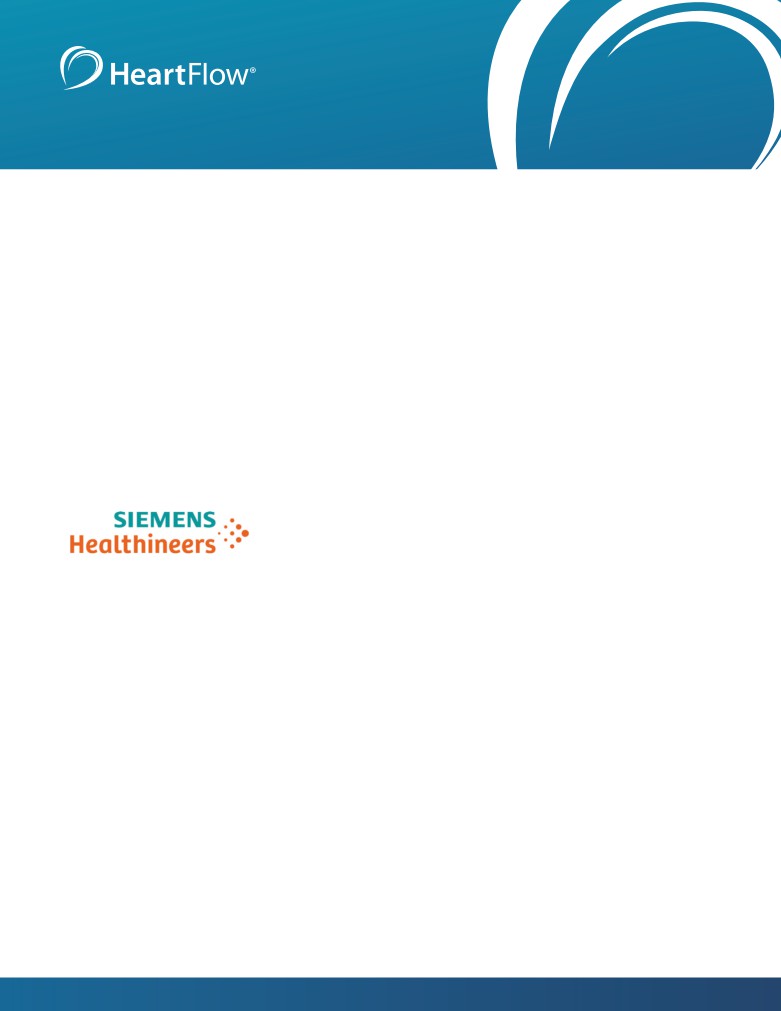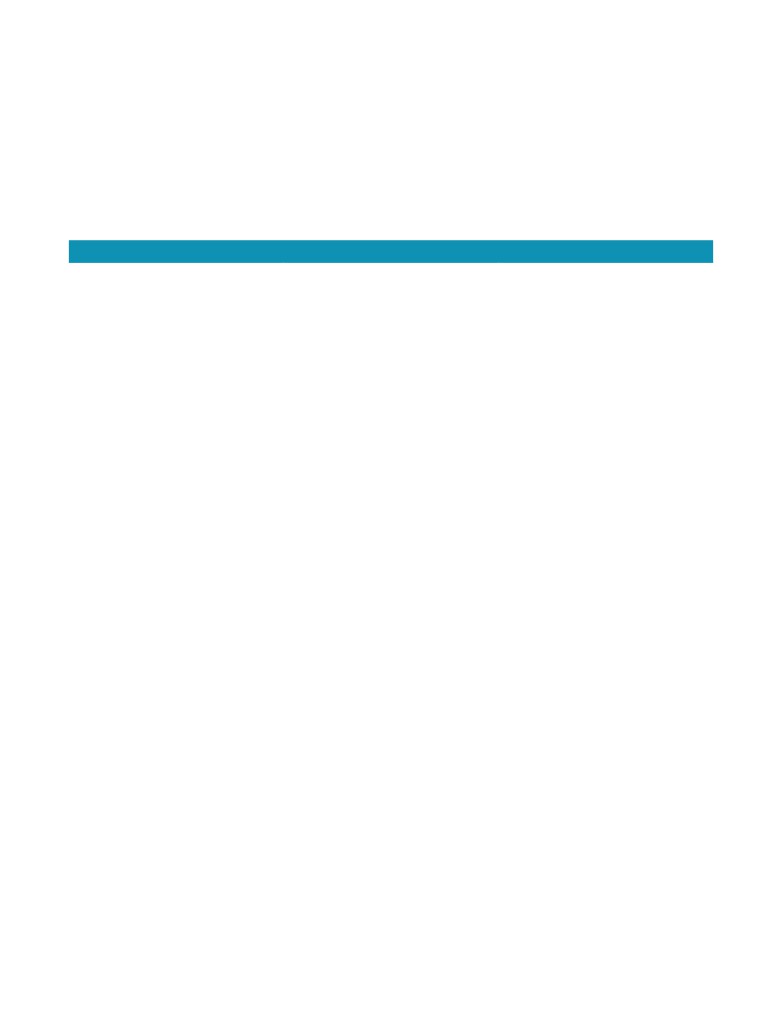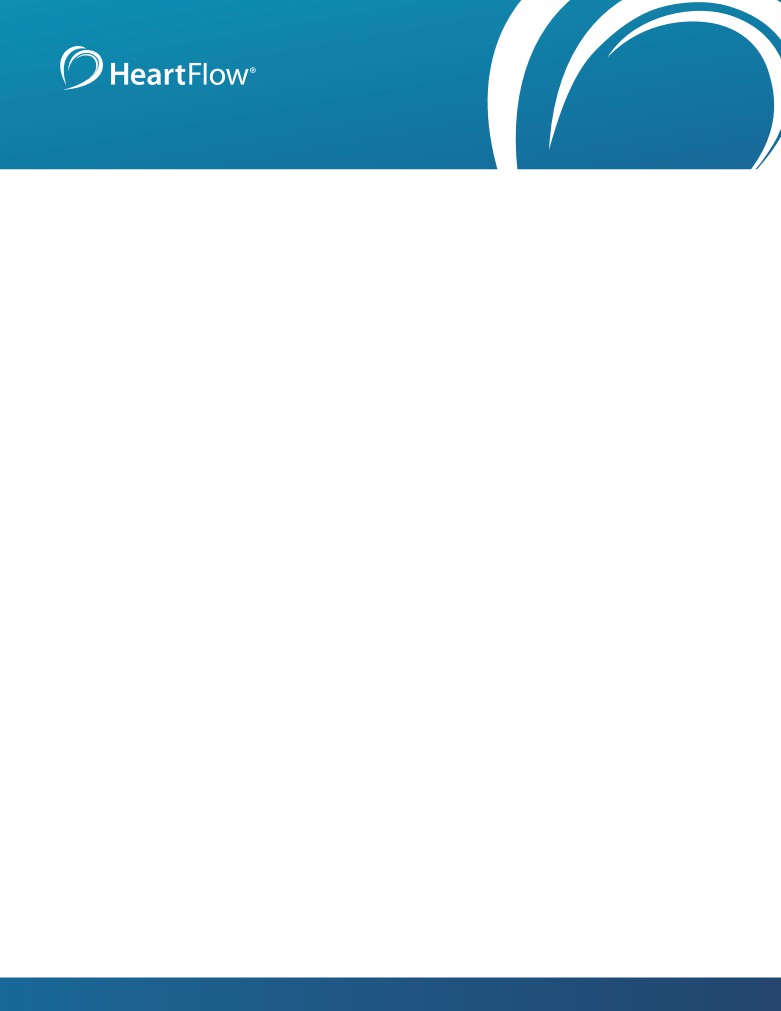Acquisition and
Reconstruction Techniques for
Coronary CT Angiography
Siemens Healthineers Scanner Platforms
Edited and Approved by
Jonathon Leipsic MD FSCCT
Past-President Society of Cardiovascular CT
1400 Seaport Blvd, Building B
| Redwood City, CA 94063
ph: +1.650.241.1221
| info@heartflow.com
| heartflow.com
15991236 V2
Table of Contents
1. Overview
3
2. Introduction
4
Importance of Heart Rate Control
4
Importance of Nitrates
4
Selection of Tube Current and Potential
5
3. Siemens SOMATOM Definition Flash, SOMATOM Drive and SOMATOM Force
6
Topogram
6
CaSc (optional) - Non-contrast Examination
7
Test Bolus
7
Alternatively, CARE Bolus
8
Prospective Adaptive Triggered Sequential Coronary CT Angiography
8
(Heart Rates: up to 80 bpm)
Alternatively, Flash/ Turbo Flash Cardio
9
(Heart Rates: Below 62 bpm (Flash/Drive), below 66 bpm (Force), stable HR)
Contrast Protocol
9
4. Siemens SOMATOM Definition AS+ & Edge
10
Topogram
10
CaSc (optional) - non-contrast examination
11
Test Bolus
11
Alternatively, CARE Bolus
12
Prospective adaptive triggered sequential coronary CT Angiography
12
(Heart Rates: up to 70 bpm)
Contrast Protocol
13
5. Siemens SOMATOM go.Top
14
Topogram
14
CaSc (optional) - non-contrast examination
15
Test Bolus
15
Alternatively, CARE Bolus
15
Coronary CT Angiography (Heart Rates: up to 70 bpm)
16
Contrast Protocol
16
6. Bibliography
17
HeartFlow, Inc.
| Acquisition and Reconstruction Techniques for Coronary CT Angiography: Siemens Healthineers Scanner Platforms
|
15991236 V2
2
1. Overview
Coronary computed tomography angiography (CCTA) is a non-invasive diagnostic for detecting coronary
artery disease (CAD). CCTA is increasingly utilized in clinical practice for evaluating coronary anatomy for
obstructive disease and plaque.
It is, however, imperative that artifact free CCTA image data is obtained in order for it to be successfully
analysed for anatomic assessment and/or to act as adequate input for adjunct analyses such as physiologic
simulations. Data acquisition strategies and scanning protocols may vary depending on scanner manufacturer,
system, and institutional preferences. This document provides references for reliable image acquisition
for CCTA.
HeartFlow, Inc.
| Acquisition and Reconstruction Techniques for Coronary CT Angiography: Siemens Healthineers Scanner Platforms
|
15991236 V2
3
2. Introduction
Image acquisition in computed tomography is governed ultimately by the principle of As Low As Reasonably
Achievable (ALARA). In the first 10 years of CCTA, the focus was almost exclusively on the detection of
anatomical stenosis in low to intermediate risk patients. With the evolution of technology, the clinical utility
of CCTA has extended beyond stenosis assessment to atherosclerosis characterization, the evaluation of
structural heart disease, and the functional and physiological assessment of coronary stenoses. Recently
the SCCT acquisition guidelines were updated and provide an excellent reference for Cardiac CT imaging
specialists to help optimize their scan protocols. That being said, given the growing information that is
provided from cardiac CT, the imaging requirements have evolved and require tailoring to meet the clinical
indication. The purpose of this white paper is to highlight the parameters and image acquisition protocols that
are important to help optimize image quality, provide accurate representation of anatomy and thus enable
quantitative CT.
Importance of Heart Rate Control
With the advancements in scanner technology, the necessary requirement for heart rate reduction has
decreased over time. The demands for a low and steady heart rate to ensure diagnostic image quality may not
be what they once were but best practice remains to optimize image quality through heart rate control. SCCT
guidelines recommend performing CCTA with heart rates below 60 bpm.
In addition, CCTA no longer simply provides stenosis evaluation but needs to enable the interpreting physician
to identify and characterize plaque and, following the identification of a stenosis, to perform functional or
physiologic evaluation. As a result, while latest generation CT scanners may enable diagnostic image quality
at higher heart rates, there remains meaningful image quality benefits from heart rate reduction. In addition,
lower heart rates allow the use of lower dose scan acquisitions that are not possible at higher heart rates. Heart
rate control strategies are well established and the appropriate strategy is dependent on a number of variables
including available medications, setting of practice and site preference. For recommendations please refer to
the recently updated SCCT acquisition guidelines.
Importance of Nitrates
Nitrates as smooth muscle dilators have direct effect on coronary vasodilation and result in tangible
enlargement of coronary size. As such, similar to invasive coronary catheterization, nitroglycerine (glyceryl
trinitrate) should be administered prior to CCTA to optimize image quality and enable the most accurate
stenosis evaluation. A commonly used regimen is 400-800 µg of sublingual nitroglycerin administered as either
sublingual tablets or a metered lingual spray (commonly 1-2 tablets or 1-2 sprays) prior to the CCTA. While
the evidence is modest and there is no randomized data, both a higher dose and administration via spray are
becoming increasingly preferred in clinical practice and have been shown to help optimize coronary evaluation.
HeartFlow, Inc.
| Acquisition and Reconstruction Techniques for Coronary CT Angiography: Siemens Healthineers Scanner Platforms
|
15991236 V2
4
Selection of Tube Current and Potential
The scan parameters used for any cardiac CT should be tailored to the individual patient but also the intended
application. The image quality issues with the greatest impact on the interpretability of CT are misalignment
and image noise. As such, care must be given to ensure that image noise properties are appropriate and
adequate for accurate lumen segmentation. To do so, tube current and potential should be selected carefully,
guided by chest wall circumference, the iodine concentration of the intravenous contrast medium, and whether
iterative reconstruction is available or not.
Iterative reconstruction (IR) has the ability to reduce image noise in CT without compromising the diagnostic
quality of the CT image dataset, which permits a significant reduction in effective radiation dose. In current
clinical practice, IR has enabled a significant reduction in radiation dose by allowing for a reduction in tube
current and is now increasingly available across all cardiac capable CT scanners. IR commonly takes the form
of a blended reconstruction of IR and filtered back projection (FBP). While a very helpful tool, care should
be given when using a very high percentage of IR for quantitative CT analysis due to the potential impact on
vessel segmentation.
HeartFlow, Inc.
| Acquisition and Reconstruction Techniques for Coronary CT Angiography: Siemens Healthineers Scanner Platforms
|
15991236 V2
5
3. Siemens SOMATOM Definition Flash,
SOMATOM Drive and SOMATOM Force
SOMATOM Definition Flash, SOMATOM Drive and Siemens SOMATOM Force are Dual Source systems
allowing for a heart rate independent temporal resolution of 75 ms for both the SOMATOM Definition Flash
and SOMATOM Drive and 66 ms for the SOMATOM Force.
1. Topogram
General
Data Acquisition (default)
Patient Preparation
AP topogram covering the chest.
• Ref. kVp: 120 kVp
• Patient positioning:
• Qual. ref. mAs: 35 mAs
The following technique provides
patient comfort and optimal image
• Slice/Collimation: 6 x 0.6 mm
quality for the study:
• Length: 512 mm
— Head or feet first, supine with
head, knees, and lower legs
supported by appropriate
accessories.
— Arms raised above the head,
resting comfortably on the head-
arm support.
— The torso of the patient must be
straight, not rotated.
— Torso in the middle of the scan
field, centered with the help of the
laser light markers.
• Place ECG-electrodes, as
anatomically depicted on the
labeled electrodes and IV access
in accordance with institutional
policies.
Recommendation: 18-gauge or
larger intravenous needle in the
right antecubital vein. Automated
contrast injection using a dual-
cylinder injector.
• Provide enough time for the patient
to practice breath hold prior to
acquisition. To avoid breathing
motion artifacts, the patient is
instructed not to breathe and
swallow during the acquisition. It
is necessary to observe the ECG
behavior during the breath hold
procedure. The heart rate may
decrease during the initial seconds
of breath-holding or increase if the
patient is straining to hold his breath
at the end of the scan.
HeartFlow, Inc.
| Acquisition and Reconstruction Techniques for Coronary CT Angiography: Siemens Healthineers Scanner Platforms
|
15991236 V2
6
2. CaSc (optional) - Non-contrast Examination
General
Data Acquisition
Data Reconstruction
Scan range of 12-15 cm from the
• Prospective ECG-triggering
• Axial reconstruction within the ECG
carina to the apex of the heart.
• Ref. kVp: 120 kVp
trigger window, commonly BestDiast
Can be used for subsequent contrast-
• Qual. ref. mAs: 80 mAs
• Field of view limited to the heart
enhanced data acquisition.
• CARE kV: Off
• Slice thickness: 3 mm
Can be used to rule out the presence
• CARE Dose4D™: on
• Increment: 1.5 mm
of excessive calcification, which may
• Rotation time: 0.28 s (SOMATOM
• WFBP Reconstruction (filtered back
reduce the diagnostic accuracy of the
Definition Flash, SOMATOM Drive)
projection) Convolution kernel:
CTA study.
0.25 s (SOMATOM Force)
B35f (SOMATOM Definition Flash,
SOMATOM Drive) Qr36 (SOMATOM
• Temporal resolution: 75 ms
Force)
(SOMATOM Definition Flash,
SOMATOM Drive) 66 ms
(SOMATOM Force)
• Slice/Collimation: 2 x 128 x 0.6 mm
(SOMATOM Definition Flash,
SOMATOM Drive) 2 x 192 x 0.6 mm
(SOMATOM Force)
• Scan direction cranio-caudal
3. Test Bolus
General
Data Acquisition
D
A series of sequential scans to
• Delay: 10 s
monitor the arrival of the bolus to
• Ref. kVp: 100 kVp
generate a time density curve. The
• Qual. ref. mAs: 24 mAs
peak of the curve is then used to
• Slice/Collimation: 1 x 10 mm
determine the scanning delay for the
• No. of scans: 15 But can be
CTA acquisition.
suspended when the bolus has
Scans are set up at the level of
passed through the region
ascending aorta at the level of the
carina. The region of interest (ROI) is
placed within the ascending aorta.
A small bolus of contrast plus saline
chaser is injected at the same
flow rate that will be used for CTA
acquisition.
HeartFlow, Inc.
| Acquisition and Reconstruction Techniques for Coronary CT Angiography: Siemens Healthineers Scanner Platforms
|
15991236 V2
7
3.1. Alternatively, CARE Bolus
General
Data Acquisition
D
CARE Bolus (automatic bolus tracking)
• Delay: 10 s
monitors the attenuation within the
• Ref. kVp: 100 kVp
vessel of interest (ascending aorta).
• Qual. Ref. mAs: 24 mAs
Scans are set up at the level of ascend-
• Slice/Collimation: 1 x 10 mm
ing aorta at the level of the carina.
The full dose of contrast media is
injected at the decided flow rate.
The CTA acquisition is automatically
triggered when the vessel
enhancement reaches the pre-
defined HU level (100- 150HU) above
the baseline. See “Contrast Protocols”
for customers’ best practice.
4. Prospective Adaptive Triggered Sequential Coronary CT Angiography (Heart Rates: up to 80 bpm)
General
Data Acquisition
Data Reconstruction
General ECG triggered Dual Source
If Test Bolus was used:
• Axial reconstruction within the ECG
data acquisition of the heart.
• Delay: time-to-peak value in s
trigger window, commonly
BestDiast.
Scan range of 12-15 cm from the
• Ref. kVp: 100 kVp *
Choose BestSyst and Millisecond
carina to the apex of the heart.
• Qual. Ref. mAs: 380 mAs (Flash)
unit for arrhythmic heart rates.
Use unenhanced CaSc CT data for
300 mAs (Drive) 300 mAs (Force)
• Field of view limited to the heart
planning if available.
• Slice/Collimation: 2 x 128 x 0.6 mm
• Slice thickness: 0.6 mm
(Flash, Drive) 2 x 192 x 0.6 mm
kV will be automatically selected by
(Force)
• Increment: 0.4 mm
CARE kV.
• CARE kV: on
• TrueStack: on
Use TrueStack reconstructions.
• CARE Dose4D™: on
• Medium smooth convolution kernel
with either filltered back projection:
• ECG Pulsing: auto
B26f Or iterative reconstruction (e.g.
• Scan direction craniocaudal
SAFIRE/ADMIRE, strength ≤ 2)
• Rotation time: 0.28 s (Flash, Drive)
• If the patient has high calcium
0.25 s (Force)
consider a sharper convolution
• Temporal resolution: 75 ms (Flash,
kernel: B46f (Flash, Drive) and
Drive) 66 ms (Force
Bv49 (Force)
• Scan window:
Stable HR
HR < 65 bpm: 70%
HR < 70 bpm: 65%-75%
HR > 70 bpm: 35%-75%
HR > 80 bpm: 30%-40%
Arrhythmic HR
(e.g. atrial fibrillation)
HR < 70 bpm: 250ms-450ms
HR > 70 bpm: 200ms-400ms
* If the patient has high calcium or
stents consider the Care kV setting to
‘Semi’ or adjust the kV to 120
HeartFlow, Inc.
| Acquisition and Reconstruction Techniques for Coronary CT Angiography: Siemens Healthineers Scanner Platforms
|
15991236 V2
8
4.1. Alternatively, Flash/ Turbo Flash Cardio (Heart Rates: Below 62 bpm (Flash/Drive), below 66 bpm (Force), stable HR)
General
Data Acquisition
Data Reconstruction
High pitch (“Flash” “Turbo Flash”)
If Test Bolus was used:
• Axial reconstruction Field of view
single heart beat acquisition.
• Delay: time-to-peak value in s
limited to the heart
Scan range of 12-15 cm from the
• Ref. kVp: 100 kVp *
• Slice thickness: 0.6 mm
carina to the apex of the heart.
• Increment: 0.4 mm
• Qual. ref. mAs: 380 mAs (Flash) 300
Use unenhanced CaSc CT data for
mAs (Drive) 300 mAs (Force)
• Medium smooth convolution kernel
planning if available.
• Slice/Collimation: 2 x 128 x 0.6
with either filtered back projection:
mm (Flash, Drive) 2 x 192 x 0.6 mm
B26f (Flash, Drive) Bv40 (Force) Or
kV will be automatically selected by
(Force)
iterative reconstruction (e.g. SAFIRE
CARE kV.
ADMIRE, strength ≤ 2)
• CARE kV: on *
• If the patient has high calcium
• CARE Dose4D™: on
consider a sharper convolution
• ECG Pulsing: auto
kernel: B46f (Flash, Drive) and
• Scan direction cranio-caudal
Bv49 (Force)
• Rotation time: 0.28 s (Flash, Drive)
0.25 s (Force)
• Temporal resolution: 75 ms (Flash,
Drive) 66 ms (Force)
• Pitch: 3.4 (Flash, Drive) 3.2 (Force)
* If the patient has high calcium or
stents consider the Care kV setting
to ‘Semi’ or adjust the kV to 120.
5. Contrast Protocol
General
Parameter
Comments
The injection rate should be
Test Bolus
increased for shorter scan times and
• CM Bolus: 10-15mL
larger patients!
• Saline chaser: 40-50mL
CTA requires contrast medium with
• Flow rate: 4-5mL/s
an iodine concentration of at least
(same as during CTA Acquisition)
350 mgI/mL.
cCTA
Place a 20- or 18-gauge IV cannula in
(Generally:)
the RIGHT arm.
• Iodine Concentration:
• 300-370mg Iodine/mL
• Contrast Volume: 50-80mL
• Saline Volume: 50mL
• Flow rate: 4-5mL/s
HeartFlow, Inc.
| Acquisition and Reconstruction Techniques for Coronary CT Angiography: Siemens Healthineers Scanner Platforms
|
15991236 V2
9
4. Siemens SOMATOM Definition AS+ & Edge
Siemens SOMATOM Definition AS+ and Edge are single source systems allowing for a temporal resolution
of 166 ms and optionally 150 ms and 142 ms, respectively, when rotation times of 300 ms and 285 ms are
employed.
1. Topogram
General
Data Acquisition (default)
Patient Preparation
AP topogram covering the chest.
• Ref. kVp: 120 kVp
• Patient positioning:
• Qual. ref. mAs: 35 mAs
The following technique provides
• Slice/Collimation: 6 x 0.6 mm
patient comfort and optimal image
quality for the study:
• Length: 512 mm
— Head or feet first, supine with
head, knees, and lower legs
supported by appropriate
accessories.
— Arms raised above the head,
resting comfortably on the head-
arm support.
— The torso of the patient must be
straight, not rotated.
— Torso in the middle of the scan
field, centered with the help of the
laser light markers.
• Place ECG-electrodes, as
anatomically depicted on the
labeled electrodes and IV access
in accordance with institutional
policies.
Recommendation: 18-gauge or
larger intravenous needle in the
right antecubital vein. Automated
contrast injection using a dual-
cylinder injector.
• Provide enough time for the patient
to practice breath hold prior to
acquisition. To avoid breathing
motion artifacts, the patient is
instructed not to breathe and
swallow during the acquisition. It
is necessary to observe the ECG
behavior during the breath hold
procedure. The heart rate may
decrease during the initial seconds
of breath-holding or increase if the
patient is straining to hold his breath
at the end of the scan.
HeartFlow, Inc.
| Acquisition and Reconstruction Techniques for Coronary CT Angiography: Siemens Healthineers Scanner Platforms
|
15991236 V2
10
2. CaSc (optional) - Non-contrast Examination
General
Data Acquisition
Data Reconstruction
Scan range of 12-15 cm from the
• Prospective ECG-triggering
• Axial reconstruction within the ECG
carina to the apex of the heart.
• Ref. kVp: 120 kVp
trigger window, commonly BestDiast
Can be used for subsequent contrast-
• Qual. ref. mAs: 40 mAs
• Field of view limited to the heart
enhanced data acquisition.
• CARE kV: semi
• Slice thickness: 3 mm
Can be used to rule out the presence
• CARE Dose4D™: on
• Increment: 1.5 mm
of excessive calcification, which may
• Rotation time: 0.30 s (SOMATOM
• WFBP Reconstruction (Filtered
reduce the diagnostic accuracy of the
Definition AS+)
Backprojection) Convolution kernel:
CTA study.
0.28 s (SOMATOM Definition Edge)
B35f
• Temporal resolution: 150 ms
(SOMATOM Definition AS+)
142 ms (SOMATOM Definition
Edge)
• Slice/Collimation: 128 x 0.6 mm
• Scan direction cranio-caudal
3. Test Bolus
General
Data Acquisition
D
A series of sequential scans to
• Delay: 10 s
monitor the arrival of the bolus to
• Ref. kVp: 100 kVp
generate a time density curve. The
• Qual. ref. mAs: 30 mAs
peak of the curve is then used to
• Slice/Collimation: 1 x 10 mm
determine the scanning delay for the
• No. of scans: 15
CTA acquisition.
But can be suspended when the
Scans are set up at the level of
bolus has passed through the region
ascending aorta at the level of the
carina. The region of interest (ROI) is
placed within the ascending aorta.
A small bolus of contrast plus saline
chaser is injected at the same
flow rate that will be used for CTA
acquisition.
HeartFlow, Inc.
| Acquisition and Reconstruction Techniques for Coronary CT Angiography: Siemens Healthineers Scanner Platforms
|
15991236 V2
11
3.1. Alternatively, CARE Bolus
General
Data Acquisition
D
CARE Bolus (automatic bolus tracking)
• Delay: 10 s
monitors the attenuation within the
• Ref. kVp: 100 kVp
vessel of interest (ascending aorta).
• Qual. Ref. mAs: 30 mAs
Scans are set up at the level of ascend-
• Slice/Collimation: 1 x 10 mm
ing aorta at the level of the carina.
The full dose of contrast media is
injected at the decided flow rate.
The CTA acquisition is automatically
triggered when the vessel enhance-
ment reaches the pre-defined HU level
(100- 150HU) above the baseline.
4. Prospective Adaptive Triggered Sequential Coronary CT Angiography (Heart Rates: up to 70 bpm)
General
Data Acquisition
Data Reconstruction
General ECG triggered data
If Test Bolus was used:
• Axial reconstruction within the ECG
acquisition of the heart.
• Delay: time-to-peak value in s
trigger window, commonly
BestDiast.
Scan range of 12-15 cm from the
• Ref. kVp: 100 kVp
Choose BestSyst and Millisecond
carina to the apex of the heart.
• Qual. Ref. mAs:190 mAs (AS+)
unit for arrhythmic heart rates
150 mAs (Edge)
Use unenhanced CaSc CT data for
• Field of view limited to the heart
planning if available.
• Slice/Collimation: 128 x 0.6 mm
• Slice thickness: 0.6 mm
• CARE kV: on *
kV will be automatically selected by
• Increment: 0.4 mm
CARE kV.
• CARE Dose4D™: on
• TrueStack: on
Use TrueStack reconstructions.
• ECG Pulsing: auto
• Medium smooth convolution kernel
• Scan direction craniocaudal
with either filltered back projection:
• Rotation time: 0.30 s (AS+)
B26f Or iterative reconstruction (e.g.
0.28 s (Edge)
SAFIRE/ADMIRE, strength ≤ 2)
• Temporal resolution: 150 ms (AS+)
• If the patient has high calcium
142 ms (Edge)
consider a sharper convolution
• Scan window:
kernel
Stable HR
HR < 70 bpm: 60%-80%
Arrhythmic HR
(e.g. atrial fibrillation)
HR < 70 bpm: 200-400 ms
For HRs > 70 bpm switch to
retrospective gated cCTA with same
parameter settings
* If the patient has high calcium or
stents consider the Care kV setting to
‘Semi’ or adjust the kV to 120
HeartFlow, Inc.
| Acquisition and Reconstruction Techniques for Coronary CT Angiography: Siemens Healthineers Scanner Platforms
|
15991236 V2
12
5. Contrast Protocol
General
Parameter
Comments
The injection rate should be
Test Bolus
increased for shorter scan times and
• CM Bolus: 10-15mL
larger patients!
• Saline chaser: 40-50mL
CTA requires contrast medium with
• Flow rate: 4-5mL/s
an iodine concentration of at least
(same as during CTA Acquisition)
350 mgI/mL.
cCTA
Place a 20- or 18-gauge IV cannula in
(Generally:)
the RIGHT arm.
• Iodine Concentration:
• 300-370mg Iodine/mL
• Contrast Volume: 50-80mL
• Saline Volume: 50mL
• Flow rate: 4-5mL/s
HeartFlow, Inc.
| Acquisition and Reconstruction Techniques for Coronary CT Angiography: Siemens Healthineers Scanner Platforms
|
15991236 V2
13
5. Siemens SOMATOM go.Top
Siemens SOMATOM go.Top is a single source system allowing for a temporal resolution of 165 ms, when
rotation times of 330 ms are employed.
1. Topogram
General
Data Acquisition (default)
Patient Preparation
AP topogram covering the chest.
• Sn100 kV; 60 mA
• Patient positioning:
• Scan mode:
The following technique provides
ScanplanningTopoAdultSn
patient comfort and optimal image
quality for the study:
• Length: 512 mm
— Head or feet first, supine with
head, knees, and lower legs
supported by appropriate
accessories.
— Arms raised above the head, resting
comfortably on the headarm
support.
— The torso of the patient must be
straight, not rotated.
— Torso in the middle of the scan field,
centered with the help of the laser
light markers.
• Place ECG-electrodes, as
anatomically depicted on the
labeled electrodes and IV access
in accordance with institutional
policies.
Recommendation: 18-gauge or
larger intravenous needle in the
right antecubital vein. Automated
contrast injection using a dual-
cylinder injector.
• Provide enough time for the patient
to practice breath hold prior to
acquisition. To avoid breathing
motion artifacts, the patient is
instructed not to breathe and
swallow during the acquisition. It
is necessary to observe the ECG
behavior during the breath hold
procedure. The heart rate may
decrease during the initial seconds
of breath-holding or increase if the
patient is straining to hold his breath
at the end of the scan.
HeartFlow, Inc.
| Acquisition and Reconstruction Techniques for Coronary CT Angiography: Siemens Healthineers Scanner Platforms
|
15991236 V2
14
2. CaSc (optional) - Non-contrast Examination
General
Data Acquisition
Data Reconstruction
Scan range of 12-15 cm from the
• Prospective ECG-triggering
• Axial reconstruction within the ECG
carina to the apex of the heart .
• CARE Dose4D™ & CARE kV:
trigger window, commonly BestDiast
Can be used for subsequent
Manual kV
• Field of view limited to the heart
contrastenhanced data acquisition.
• Qual. ref. mAs @ 120 kV: 20 mAs
• Slice thickness: 3 mm
• Scan mode: CardiacSequenceAdult
• Increment: 1.5 mm
Can be used to rule out the presence
of excessive calcification, which may
• Scan direction cranio-caudal
• WFBP Reconstruction (Filtered
reduce the diagnostic accuracy of the
Backprojection) Convolution kernel:
CTA study.
Qr36
3. Test Bolus
General
Data Acquisition
D
A series of sequential scans to
• Delay: 8 s
monitor the arrival of the bolus to
• CARE Dose4D™ & CARE kV:
generate a time density curve. The
Manual kV
peak of the curve is then used to
• Qual. ref. mAs @ 120 kV: 20 mAs
determine the scanning delay for the
• Slice/Collimation: 1 x 10 mm
CTA acquisition.
• Scan mode:
Scans are set up at the level of
BolusSequenceAdult2d
ascending aorta at the level of the
• No. of scans: 15
carina. The region of interest (ROI) is
• Cycle time: 1.5 s
placed within the ascending aorta.
But can be suspended when the
A small bolus of contrast plus saline
bolus has passed through the region
chaser is injected at the same
flow rate that will be used for CTA
acquisition.
3.1. Alternatively, CARE Bolus
General
Data Acquisition
D
CARE Bolus (automatic bolus
• Delay: 10 s
tracking) monitors the attenuation
• CARE Dose4D™ & CARE kV:
within the vessel of interest
Manual kV
(ascending aorta). Scans are set
• Qual. ref. mAs @ 120 kV: 20 mAs
up at the level of ascending aorta
• Slice/Collimation: 1 x 10 mm
at the level of the carina. The full
• Scan mode:
dose of contrast media is injected
BolusSequenceAdult2d
at the decided flow rate. The CTA
acquisition is automatically triggered
when the vessel enhancement
reaches the pre-defined HU level
(100- 150HU) above the baseline.
HeartFlow, Inc.
| Acquisition and Reconstruction Techniques for Coronary CT Angiography: Siemens Healthineers Scanner Platforms
|
15991236 V2
15
4. Coronary CT Angiography (Heart Rates: up to 70 bpm)
General
Data Acquisition
Data Reconstruction
General ECG triggered data
If Test Bolus was used:
Axial reconstruction within the ECG
acquisition of the heart.
• Delay: time-to-peak value in s + 3 s
trigger window, commonly BestDiast.
Choose BestSyst and Millisecond unit
Scan range of 12-15 cm from the
• CARE Dose4D™ & CARE kV*: Full
for arrhythmic heart rates
carina to the apex of the heart.
• Qual. Ref. mAs @ 120 kV: 70 mAs
• Field of view limited to the heart
Use unenhanced CaSc CT data
+ different geometry of systems
• Slice thickness: 0.8 mm
for planning if available. kV will be
• Scan mode:
• Increment: 0.5 mm
automatically selected by CARE kV.
CardiacSpiralAdultAngio
• Medium smooth convolution kernel
• ECG Pulsing: Standard
with either filtered back projection:
• Pulsing window:
Bv40 or iterative reconstruction (e.g.
Stable HR
SAFIRE/ADMIRE, strength ≤ 2)
HR < 70 bpm: 65%-85%
• If the patient has high calcium
HR > 70 bpm: 30%-80%
consider a sharper convolution
Arrhythmic HR
kernel (Bv49)
(e.g. atrial fibrillation)
• Enable TrueStack option to be
250-450 ms
switched on
* If the patient has high calcium or
stents consider the CARE kV setting
to ‘Manual kV’ or adjust the kV to
values equal to 120 kV. Additionally
define the minimum voltage for
CARE kV in the scan protocol
assistant to be 80 kV for adults.
5. Contrast Protocol
General
Data Acquisition
D
The injection rate should be
Test Bolus
increased for shorter scan times and
• CM Bolus: 10-15mL
larger patients!
• Saline chaser: 40-50mL
CTA requires contrast medium with
• Flow rate: 4-5mL/s
an iodine concentration of at least
(same as during CTA Acquisition)
350 mgI/mL.
cCTA
Place a 20- or 18-gauge IV cannula in
(Generally:)
the RIGHT arm.
• Iodine Concentration:
• 300-370mg Iodine/mL
• Contrast Volume: 50-80mL
• Saline Volume: 50mL
• Flow rate: 4-5mL/s
HeartFlow, Inc.
| Acquisition and Reconstruction Techniques for Coronary CT Angiography: Siemens Healthineers Scanner Platforms
|
15991236 V2
16
6. Bibliography
1.
Dewey M, Hoffmann H, Hamm B. Multislice CT coronary angiography: effect of sublingual nitroglycerine
on the diameter of coronary arteries. RoFo: Fortschritte auf dem Gebiete der Rontgenstrahlen und der
Nuklearmedizin. 2006;178(6):600-4.
2.
Decramer I, Vanhoenacker PK, Sarno G, Van Hoe L, Bladt O, Wijns W, et al. Effects of sublingual
nitroglycerin on coronary lumen diameter and number of visualized septal branches on 64-MDCT
angiography. American Journal of Roentgenology. 2008;190(1):219-25.
3.
Laslett LJ, Baker L. Sublingual nitroglycerin administered by spray versus tablet: comparative timing of
hemodynamic effects. Cardiology. 1990;77(4):303-10.
4.
Bachmann KF, Gansser RE. Nitroglycerin oral spray: evaluation of its coronary artery dilative action by
quantitative angiography. The American journal of cardiology. 1988;61(9):7E-11E.
5.
Sato K, et al. Optimal starting time of acquisition and feasibility of complementary administration of
nitroglycerin with intravenous beta-blocker in multislice computed tomography. JCCT. 2009;33(2):193)
6.
Abbara S, Blanke P, Maroules CD, Cheezum M, Choi AD, Han BK, Marwan M, Naoum C, Norgaard BL,
Rubinshtein R, Schoenhagen P, Villines T, Leipsic J. SCCT guidelines for the performance and acquisition
of coronary computed tomographic angiography: A report of the society of Cardiovascular Computed
Tomography Guidelines Committee: Endorsed by the North American Society for Cardiovascular Imaging
(NASCI). J Cardiovasc Comput Tomogr. 2016 Oct 12. pii: S1934-5925(16)30239-8.
7.
Leipsic J, Abbara S, Achenbach S, Cury R, Earls JP, Mancini GJ, et al. SCCT guidelines for the interpretation
and reporting of coronary CT angiography: a report of the Society of Cardiovascular Computed
Tomography Guidelines Committee. Journal of cardiovascular computed tomography. 2014;8(5):342-58.
8.
Budoff MJ, Dowe D, Jollis JG, Gitter M, Sutherland J, Halamert E, et al. Diagnostic performance of
64-multidetector row coronary computed tomographic angiography for evaluation of coronary artery
stenosis in individuals without known coronary artery disease: results from the prospective multicenter
ACCURACY (Assessment by Coronary Computed Tomographic Angiography of Individuals Undergoing
Invasive Coronary Angiography) trial. Journal of the American College of Cardiology. 2008;52(21):1724-32.
9.
Meijboom WB, Meijs MF, Schuijf JD, Cramer MJ, Mollet NR, van Mieghem CA, et al. Diagnostic accuracy
of 64-slice computed tomography coronary angiography: a prospective, multicenter, multivendor study.
Journal of the American College of Cardiology. 2008;52(25):2135-44.
10. Miller JM, Rochitte CE, Dewey M, Arbab-Zadeh A, Niinuma H, Gottlieb I, et al. Diagnostic performance of
coronary angiography by 64-row CT. The New England journal of medicine. 2008;359(22):2324-36.
11. Min JK, Shaw LJ, Devereux RB, Okin PM, Weinsaft JW, Russo DJ, et al. Prognostic value of multidetector
coronary computed tomographic angiography for prediction of all-cause mortality. Journal of the
American College of Cardiology. 2007;50(12):1161-70.
HeartFlow, Inc.
| Acquisition and Reconstruction Techniques for Coronary CT Angiography: Siemens Healthineers Scanner Platforms
|
15991236 V2
17
12. Min JK, Dunning A, Lin FY, Achenbach S, Al-Mallah M, Budoff MJ, et al. Age- and sex-related differences
in all-cause mortality risk based on coronary computed tomography angiography findings results from
the International Multicenter CONFIRM (Coronary CT Angiography Evaluation for Clinical Outcomes: An
International Multicenter Registry) of 23,854 patients without known coronary artery disease. Journal of the
American College of Cardiology. 2011;58(8):849-60.
13. Villines TC, Hulten EA, Shaw LJ, Goyal M, Dunning A, Achenbach S, et al. Prevalence and severity of
coronary artery disease and adverse events among symptomatic patients with coronary artery calcification
scores of zero undergoing coronary computed tomography angiography: results from the CONFIRM
(Coronary CT Angiography Evaluation for Clinical Outcomes: An International Multicenter) registry. Journal
of the American College of Cardiology. 2011;58(24):2533-40.
14. Leipsic J, Taylor CM, Gransar H, Shaw LJ, Ahmadi A, Thompson A, et al. Sex-based prognostic implications
of nonobstructive coronary artery disease: results from the international multicenter CONFIRM study.
Radiology. 2014;273(2):393-400.
15. Taylor AJ, Cerqueira M, Hodgson JM, Mark D, Min J, O'Gara P, et al. ACCF/SCCT/ACR/AHA/ASE/
ASNC/NASCI/SCAI/SCMR 2010 appropriate use criteria for cardiac computed tomography. A report
of the American College of Cardiology Foundation Appropriate Use Criteria Task Force, the Society
of Cardiovascular Computed Tomography, the American College of Radiology, the American Heart
Association, the American Society of Echocardiography, the American Society of Nuclear Cardiology,
the North American Society for Cardiovascular Imaging, the Society for Cardiovascular Angiography and
Interventions, and the Society for Cardiovascular Magnetic Resonance. Journal of the American College of
Cardiology. 2010;56(22):1864-94.
16. Jacobs JE, Boxt LM, Desjardins B, Fishman EK, Larson PA, Schoepf J, et al. ACR practice guideline for the
performance and interpretation of cardiac computed tomography (CT). Journal of the American College of
Radiology : JACR. 2006;3(9):677-85.
17. Halliburton SS, Abbara S, Chen MY, Gentry R, Mahesh M, Raff GL, et al. SCCT guidelines on radiation dose
and dose-optimization strategies in cardiovascular CT. Journal of cardiovascular computed tomography.
2011;5(4):198-224.
18. Valentin J. Pregnancy and medical radiation: ICRP publication 84. . Ann ICRP 2000(30(1)):1-39.
19. Chen MM, Coakley FV, Kaimal A, Laros RK, Jr. Guidelines for computed tomography and magnetic
resonance imaging use during pregnancy and lactation. Obstet Gynecol. 2008;112(2 Pt 1):333-340.
20. Woussen S1, Lopez-Rendon X, Vanbeckevoort D, Bosmans H, Oyen R, Zanca F. Clinical indications and
radiation doses to the conceptus associated with CT imaging in pregnancy: a retrospective study. Eur
Radiol. 2015 Jul 23.
21. Webb JA, Thomsen HS, Morcos SK, Members of Contrast Media Safety Committee of European Society
of Urogenital R. The use of iodinated and gadolinium contrast media during pregnancy and lactation.
European radiology. 2005;15(6):1234-40.
HeartFlow, Inc.
| Acquisition and Reconstruction Techniques for Coronary CT Angiography: Siemens Healthineers Scanner Platforms
|
15991236 V2
18
22. Rubin G, Bluemke D, Duerinckx A, Flamm S, Grist T, Jacobs J, et al. ACR Committee on Cardiac Imaging.
Practice guideline for the performance and interpretation of cardiac computed tomography (CT). (Res. 10,
16g, 17, 34, 35, 36 - 2006) In: Practice Guidelines and Technical Standards. Reston, VA: American College
of Radiology. 2008;421-30.
23. Greenberger P, Patterson R. Prednisone-diphenhydramine regimen prior to use of radiographic contrast
media. The Journal of allergy and clinical immunology. 1979;63(4):295.
24. Zeiher AM, Schachinger V, Minners J. Long-term cigarette smoking impairs endothelium-dependent
coronary arterial vasodilator function. Circulation. 1995;92(5):1094-100.
25. Quillen JE, Rossen JD, Oskarsson HJ, Minor RL, Jr., Lopez AG, Winniford MD. Acute effect of cigarette
smoking on the coronary circulation: constriction of epicardial and resistance vessels. Journal of the
American College of Cardiology. 1993;22(3):642-7.
26. Elicker BM, Cypel YS, Weinreb JC. IV contrast administration for CT: a survey of practices for the screening
and prevention of contrast nephropathy. AJR American journal of roentgenology. 2006;186(6):1651-8.
27. Lee JK, Warshauer DM, Bush WH, Jr., McClennan BL, Choyke PL. Determination of serum creatinine
level before intravenous administration of iodinated contrast medium. A survey. Investigative radiology.
1995;30(12):700-5.
28. Owen RJ, Hiremath S, Myers A, Fraser-Hill M, Barrett BJ. Canadian Association of Radiologists consensus
guidelines for the prevention of contrast-induced nephropathy: update 2012. Canadian Association of
Radiologists journal = Journal l'Association canadienne des radiologistes. 2014;65(2):96-105.
29. Owen at al. Canadian Association of Radiologists consensus guidelines for the prevention of contrast-
induced nephropathy. Can Assoc Radiol J. 2014 May;65(2):96-105
30. Briguori C, Airoldi F, D'Andrea D, Bonizzoni E, Morici N, Focaccio A, et al. Renal Insufficiency Following
Contrast Media Administration Trial (REMEDIAL): a randomized comparison of 3 preventive strategies.
Circulation. 2007;115(10):1211-7.
31. Briguori C, Colombo A, Violante A, Balestrieri P, Manganelli F, Paolo Elia P, et al. Standard vs double
dose of N-acetylcysteine to prevent contrast agent associated nephrotoxicity. European heart journal.
2004;25(3):206-11.
32. Lee PT, Chou KJ, Liu CP, Mar GY, Chen CL, Hsu CY, et al. Renal protection for coronary angiography in
advanced renal failure patients by prophylactic hemodialysis. A randomized controlled trial. Journal of the
American College of Cardiology. 2007;50(11):1015-20.
33. Marenzi G, Assanelli E, Marana I, Lauri G, Campodonico J, Grazi M, et al. N-acetylcysteine and contrast-
induced nephropathy in primary angioplasty. The New England journal of medicine. 2006;354(26):2773-82.
34. McDonald R, Mdcondal J, Bida Jet al Intravenous Contrast Material-induced Nephropathy:
35. Causal or Coincident Phenomenon?. RadiologyVolume 267: Number 1—April 2013
HeartFlow, Inc.
| Acquisition and Reconstruction Techniques for Coronary CT Angiography: Siemens Healthineers Scanner Platforms
|
15991236 V2
19
36. Newhouse JH, Kho D, Rao QA, Starren J. Frequency of serum creatinine changes in the absence of
iodinated contrast material: implications for studies of contrast nephrotoxicity. AJR American journal of
roentgenology. 2008;191(2):376-82.
37. McDonald RJ, McDonald JS, Carter RE, Hartman RP, Katzberg RW, Kallmes DF, et al. Intravenous contrast
material exposure is not an independent risk factor for dialysis or mortality. Radiology. 2014;273(3):714-25.
38. Owen RJ, Hiremath S, Myers A, Fraser-Hill M, Barrett BJ. Canadian Association of Radiologists consensus
guidelines for the prevention of contrast-induced nephropathy: update 2012. Canadian Association of
Radiologists journal = Journal l'Association canadienne des radiologistes. 2014;65(2):96-105.
39. Ahuja TS, Niaz N, Agraharkar M. Contrast-induced nephrotoxicity in renal allograft recipients. Clinical
nephrology. 2000;54(1):11-4.
40. Brodoefel H, Reimann A, Heuschmid M, Kuttner A, Beck T, Burgstahler C, et al. Non-invasive coronary
angiography with 16-slice spiral computed tomography: image quality in patients with high heart rates.
European radiology. 2006;16(7):1434-41.
41. Cademartiri F, Mollet NR, Runza G, Belgrano M, Malagutti P, Meijboom BW, et al. Diagnostic accuracy of
multislice computed tomography coronary angiography is improved at low heart rates. The international
journal of cardiovascular imaging. 2006;22(1):101-5; discussion 7-9.
42. Achenbach S, Manolopoulos M, Schuhback A, Ropers D, Rixe J, Schneider C, et al. Influence of heart rate
and phase of the cardiac cycle on the occurrence of motion artifact in dual-source CT angiography of the
coronary arteries. Journal of cardiovascular computed tomography. 2012;6(2):91-8.
43. Le Jemtel TH, Padeletti M, Jelic S. Diagnostic and therapeutic challenges in patients with coexistent chronic
obstructive pulmonary disease and chronic heart failure. Journal of the American College of Cardiology.
2007;49(2):171-80.
44. Maffei E, Palumbo AA, Martini C, Tedeschi C, Tarantini G, Seitun S, et al. "In-house" pharmacological
management for computed tomography coronary angiography: heart rate reduction, timing and safety of
different drugs used during patient preparation. European radiology. 2009;19(12):2931-40.
45. Roberts WT, Wright AR, Timmis JB, Timmis AD. Safety and efficacy of a rate control protocol for cardiac CT.
The British journal of radiology. 2009;82(976):267-71.
46.
40. Earls et al JCCT Metoprolol
47. Sadamatsu K, Koide S, Nakano K, Yoshida K. Heart rate control with single administration of a long-acting
beta-blocker at bedtime before coronary computed tomography angiography. Journal of cardiology.
2015;65(4):293-7.
48. Clayton B, Raju V, Roobottom C, Morgan-Hughes G. Safety of intravenous beta-adrenoceptor blockers for
computed tomographic coronary angiography. British journal of clinical pharmacology. 2015;79(3):533-6.
49. Kassamali RH, Kim DH, Patel H, Raichura N, Hoey ET, Hodson J, et al. Safety of an i.v. beta-adrenergic
blockade protocol for heart rate optimization before coronary CT angiography. AJR American journal of
roentgenology. 2014;203(4):759-62.
HeartFlow, Inc.
| Acquisition and Reconstruction Techniques for Coronary CT Angiography: Siemens Healthineers Scanner Platforms
|
15991236 V2
20
50. Wang JD, Zhang HW, Xin Q, Yang JJ, Sun ZJ, Liu HB, et al. Safety and efficacy of intravenous esmolol before
prospective electrocardiogram-triggered high-pitch spiral acquisition for computed tomography coronary
angiography. Journal of geriatric cardiology : JGC. 2014;11(1):39-43.
51. Dobre D, Borer JS, Fox K, Swedberg K, Adams KF, Cleland JG, et al. Heart rate: a prognostic factor and
therapeutic target in chronic heart failure. The distinct roles of drugs with heart rate-lowering properties.
European journal of heart failure. 2014;16(1):76-85.
52. Pichler P, Pichler-Cetin E, Vertesich M, Mendel H, Sochor H, Dock W, et al. Ivabradine versus metoprolol
for heart rate reduction before coronary computed tomography angiography. The American journal of
cardiology. 2012;109(2):169-73.
53. Celik O, Atasoy MM, Erturk M, Yalcin AA, Aksu HU, Diker M, et al. Comparison of different strategies of
ivabradine premedication for heart rate reduction before coronary computed tomography angiography.
Journal of cardiovascular computed tomography. 2014;8(1):77-82.
54. Guaricci AI, Schuijf JD, Cademartiri F, Brunetti ND, Montrone D, Maffei E, et al. Incremental value and safety
of oral ivabradine for heart rate reduction in computed tomography coronary angiography. International
journal of cardiology. 2012;156(1):28-33.
55. Guaricci AI, Maffei E, Brunetti ND, Montrone D, Di Biase L, Tedeschi C, et al. Heart rate control with oral
ivabradine in computed tomography coronary angiography: a randomized comparison of 7.5 mg vs 5 mg
regimen. International journal of cardiology. 2013;168(1):362-8.
56. Adile KK, Kapoor A, Jain SK, Gupta A, Kumar S, Tewari S, et al. Safety and efficacy of oral ivabradine as
a heart rate-reducing agent in patients undergoing CT coronary angiography. The British journal of
radiology. 2012;85(1016):e424-8.
57. Cademartiri F, Garot J, Tendera M, Zamorano JL. Intravenous ivabradine for control of heart rate during
coronary CT angiography: A randomized, double-blind, placebo-controlled trial. Journal of cardiovascular
computed tomography. 2015;9(4):286-94.
58. Parker JD, Parker JO. Nitrate therapy for stable angina pectoris. The New England journal of medicine.
1998;338(8):520-31.
59. Dewey M, Hoffmann H, Hamm B. Multislice CT coronary angiography: effect of sublingual nitroglycerine
on the diameter of coronary arteries. RoFo : Fortschritte auf dem Gebiete der Rontgenstrahlen und der
Nuklearmedizin. 2006;178(6):600-4.
60. Decramer I, Vanhoenacker PK, Sarno G, Van Hoe L, Bladt O, Wijns W, et al. Effects of sublingual
nitroglycerin on coronary lumen diameter and number of visualized septal branches on 64-MDCT
angiography. AJR American journal of roentgenology. 2008;190(1):219-25.
61. Laslett LJ, Baker L. Sublingual nitroglycerin administered by spray versus tablet: comparative timing of
hemodynamic effects. Cardiology. 1990;77(4):303-10.
62. Bachmann KF, Gansser RE. Nitroglycerin oral spray: evaluation of its coronary artery dilative action by
quantitative angiography. The American journal of cardiology. 1988;61(9):7E-11E.
HeartFlow, Inc.
| Acquisition and Reconstruction Techniques for Coronary CT Angiography: Siemens Healthineers Scanner Platforms
|
15991236 V2
21
63. Sato K, et al. Optimal starting time of acquisition and feasibility of complementary administration of
nitroglycerin with intravenous beta-blocker in multislice computed tomography. JCCT. 2009;33(2):193)
64. Chun EJ et al J. Effects of nitroglycerin on the diagnostic accuracy of electrocardiogram-gated coronary
computed tomography angiography. JCCT. 2008;32(1):86-92)
65. Wang G, Vannier MW. Spatial variation of section sensitivity profile in spiral computed tomography.
Medical physics. 1994;21(9):1491-7.
66. Ohnesorge B, Flohr T, Becker C, Kopp AF, Schoepf UJ, Baum U, et al. Cardiac imaging by means of
electrocardiographically gated multisection spiral CT: initial experience. Radiology. 2000;217(2):564-71.
67. Halliburton SS, Abbara S. Practical tips and tricks in cardiovascular computed tomography: patient
preparation for optimization of cardiovascular CT data acquisition. Journal of cardiovascular computed
tomography. 2007;1(1):62-5.
68. Bae KT, Tran HQ, Heiken JP. Multiphasic injection method for uniform prolonged vascular enhancement
at CT angiography: pharmacokinetic analysis and experimental porcine model. Radiology.
2000;216(3):872-80.
69. Fleischmann D, Rubin GD, Bankier AA, Hittmair K. Improved uniformity of aortic enhancement with
customized contrast medium injection protocols at CT angiography. Radiology. 2000;214(2):363-71.
70. Haage P, Schmitz-Rode T, Hubner D, Piroth W, Gunther RW. Reduction of contrast material dose and
artifacts by a saline flush using a double power injector in helical CT of the thorax. AJR American journal of
roentgenology. 2000;174(4):1049-53.
71. Hopper KD, Mosher TJ, Kasales CJ, TenHave TR, Tully DA, Weaver JS. Thoracic spiral CT: delivery of contrast
material pushed with injectable saline solution in a power injector. Radiology. 1997;205(1):269-71.
72. Raju R, Thompson AG, Lee K, Precious B, Yang TH, Berger A, et al. Reduced iodine load with CT coronary
angiography using dual-energy imaging: a prospective randomized trial compared with standard coronary
CT angiography. Journal of cardiovascular computed tomography. 2014;8(4):282-8.
73. Carrascosa P, Leipsic JA, Capunay C, Deviggiano A, Vallejos J, Goldsmit A, et al. Monochromatic
image reconstruction by dual energy imaging allows half iodine load computed tomography coronary
angiography. European journal of radiology. 2015.
74. Yin WH, Lu B, Gao JB, Li PL, Sun K, Wu ZF, et al. Effect of reduced x-ray tube voltage, low iodine
concentration contrast medium, and sinogram-affirmed iterative reconstruction on image quality and
radiation dose at coronary CT angiography: results of the prospective multicenter REALISE trial. Journal of
cardiovascular computed tomography. 2015;9(3):215-24.
75. Hein PA, May J, Rogalla P, Butler C, Hamm B, Lembcke A. Feasibility of contrast material volume reduction
in coronary artery imaging using 320-slice volume CT. European radiology. 2010;20(6):1337-43.
76. Kim R, et al. Feasibility of 320-row CT coronary angiography using 40 mL…Eur Radiol. 2016; Feb 23 (Epub
ahead of print).
HeartFlow, Inc.
| Acquisition and Reconstruction Techniques for Coronary CT Angiography: Siemens Healthineers Scanner Platforms
|
15991236 V2
22
77. Marwan et al Radiology High Pitch TAVR
78. Segal A, Ellis J, Baumgartner B, Choyke P, Cohan R, Costouros N, et al. ACR Committee on Drugs and
Contrast Media. Practice guideline for the use of intravascular contrast media. (Res. 38 - 2007) In: Practice
Guidelines and Technical Standards. Reston, VA: . American College of Radiology. 2008;73-78.
79. Brenner DJ, Doll R, Goodhead DT, Hall EJ, Land CE, Little JB, et al. Cancer risks attributable to low doses of
ionizing radiation: assessing what we really know. Proceedings of the National Academy of Sciences of the
United States of America. 2003;100(24):13761-6.
80. Committee to Assess Health Risks from Exposure to Low Levels of Ionizing Radiation; Nuclear and
Radiation Studies Board, Division on Earth and Life Studies, National Research Council of the National
Academies. Health Risks From Exposure to Low Levels of Ionizing Radiation: BEIR VII Phase 2. Washington,
DC: The National Academies Press. 2006.
81. Don S. Radiosensitivity of children: potential for overexposure in CR and DR and magnitude of doses in
ordinary radiographic examinations. Pediatric radiology. 2004;34 Suppl 3:S167-72; discussion S234-41.
82. Einstein AJ, Henzlova MJ, Rajagopalan S. Estimating risk of cancer associated with radiation exposure
from 64-slice computed tomography coronary angiography. JAMA : the journal of the American Medical
Association. 2007;298(3):317-23.
83. Deseive S, Chen MY, Korosoglou G, Leipsic J, Martuscelli E, Carrascosa P, et al. Prospective Randomized
Trial on Radiation Dose Estimates of CT Angiography Applying Iterative Image Reconstruction: The
PROTECTION V Study. JACC Cardiovascular imaging. 2015;8(8):888-96.
84. Deseive S, Pugliese F, Meave A, Alexanderson E, Martinoff S, Hadamitzky M, et al. Image quality and
radiation dose of a prospectively electrocardiography-triggered high-pitch data acquisition strategy for
coronary CT angiography: The multicenter, randomized PROTECTION IV study. Journal of cardiovascular
computed tomography. 2015;9(4):278-85.
85. Hausleiter J, Martinoff S, Hadamitzky M, Martuscelli E, Pschierer I, Feuchtner GM, et al. Image quality
and radiation exposure with a low tube voltage protocol for coronary CT angiography results of the
PROTECTION II Trial. JACC Cardiovascular imaging. 2010;3(11):1113-23.
86. Hausleiter J, Meyer TS, Martuscelli E, Spagnolo P, Yamamoto H, Carrascosa P, et al. Image quality and
radiation exposure with prospectively ECG-triggered axial scanning for coronary CT angiography:
the multicenter, multivendor, randomized PROTECTION-III study. JACC Cardiovascular imaging.
2012;5(5):484-93.
87. Chen MY, et al. Submillisievert median radiation dose for coronary angiography with a second-generation
320-detector row CTscanner in 107 consecutive patients. Radiology. 2013 Apr;267(1):76-85. doi: 10.1148/
radiol.13122621. Epub 2013 Jan 22.
88. Zhao L, Plank F, Kummann M, Burghard P, Klauser A, Dichtl W, Feuchtner G. Improved non-calcified plaque
delineation on coronary CT angiography by sonogram-affirmed iterative reconstruction withdifferent filter
strength and relationship with BMI. Cardiovasc Diagn Ther. 2015 Apr;5(2):104-12.
HeartFlow, Inc.
| Acquisition and Reconstruction Techniques for Coronary CT Angiography: Siemens Healthineers Scanner Platforms
|
15991236 V2
23
89. Task Group on Control of Radiation Dose in Computed T. Managing patient dose in computed
tomography. A report of the International Commission on Radiological Protection. Annals of the ICRP.
2000;30(4):7-45.
90. Hausleiter J, Meyer T, Hadamitzky M, Huber E, Zankl M, Martinoff S, et al. Radiation dose estimates from
cardiac multislice computed tomography in daily practice: impact of different scanning protocols on
effective dose estimates. Circulation. 2006;113(10):1305-10.
91. Siegel MJ, Schmidt B, Bradley D, Suess C, Hildebolt C. Radiation dose and image quality in pediatric CT:
effect of technical factors and phantom size and shape. Radiology. 2004;233(2):515-22.
92. Leipsic J, LaBounty TM, Mancini GB, Heilbron B, Taylor C, Johnson MA, et al. A prospective randomized
controlled trial to assess the diagnostic performance of reduced tube voltage for coronary CT
angiography. AJR American journal of roentgenology. 2011;196(4):801-6.
93. Oda S, Utsunomiya D, Funama Y, Yonenaga K, Namimoto T, Nakaura T, et al. A hybrid iterative
reconstruction algorithm that improves the image quality of low-tube-voltage coronary CT angiography.
AJR American journal of roentgenology. 2012;198(5):1126-31.
94. Williams MC, Weir NW, Mirsadraee S, Millar F, Baird A, Minns F, et al. Iterative reconstruction and
individualized automatic tube current selection reduce radiation dose while maintaining image quality in
320-multidetector computed tomography coronary angiography. Clinical radiology. 2013;68(11):e570-7.
95. Deseive S, Pugliese F, Meave A, Alexanderson E, Martinoff S, Hadamitzky M, et al. Image quality and
radiation dose of a prospectively electrocardiography-triggered high-pitch data acquisition strategy for
coronary CT angiography: The multicenter, randomized PROTECTION IV study. Journal of cardiovascular
computed tomography. 2015;9(4):278-85.
This paper is presented as a service to medical personnel by HeartFlow and Siemens. The information in this white paper has been compiled
from available literature and best practices from expert users. Although every effort has been made to faithfully convey this information, the
editors and publisher cannot be held responsible for their correctness. This paper is not intended to be, and should not be construed as,
medical advice. For any use, the product information guides, inserts, and operation manuals of the various CT acquisition devices should
be consulted. HeartFlow and the editors disclaim any liability arising directly or indirectly from the use of drugs, devices, techniques, or
procedures described in this paper.
WARNING: Any references to x-ray exposure, intravenous contrast dosage, and other medication are intended as reference guidelines only.
The guidelines in this document do not substitute for the judgment of a trained healthcare provider. Each scan requires medical judgment by
the healthcare provider about exposing the patient to ionizing radiation. Use the As Low As Reasonably Achievable (ALARA) radiation dose
principle to balance factors such as the patient’s condition, size and age; region to be imaged; and diagnostic task.
HeartFlow, Inc.
| Acquisition and Reconstruction Techniques for Coronary CT Angiography: Siemens Healthineers Scanner Platforms
|
15991236 V2
24
1400 Seaport Blvd, Building B
| Redwood City, CA 94063
ph: +1.650.241.1221
| info@heartflow.com
| heartflow.com
© 2019 HeartFlow, Inc. HeartFlow and the HeartFlow logo are among trademarks of HeartFlow, Inc.
15991236 V2
























